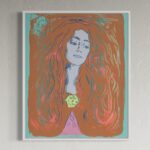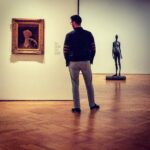By Reed V. Horth, for Robin Rile Fine Art
Real estate commodities have been an ever-expanding market in Miami in the past several years due not only to a rebound in the global markets, but also a preponderance of investors looking for savvy properties in the United States in which to place excess capital with ample room for growth. Foreign investors have pushed Miami luxury home prices up more than 13% in the past 12 months alone. Prices in Miami Beach are up 27% and prices in downtown Miami up 19%. These numbers are difficult to ignore.
- Mark Rothko’s “Orange Red Yellow” (1961) sold for an astounding $86M in 2012.
Similarly, but perhaps more dramatically, is the global Art market which has increased a whopping 63% since the market crisis in 2009 to over $55 Billion USD. The modern and contemporary art markets (which comprise nearly 70% of the art market) have seen levels in excess of the 2007-2008 boom. [1] In 2011, original artworks from Clyfford Still ($62M) Gustav Klimt ($40M), Andy Warhol ($38M), Mark Rothko ($34M) and Francis Bacon ($25M) sold in the same vicinity as Fifth Avenue mansions of New York icons with surnames such as Getty, Vanderbilt and Guggenheim (between $26M-$88M) [2]. In 2011, Andy Warhol’s total sale volume rose 4% on a .5% rise in lots sold to a total of $325M USD. Picasso sales totaled $314M on 3,387 lots sold. [3] Benjamin Mandel, an economist at the Federal Reserve Bank of New York, has been studying subtleties in the art market because, he says, “it’s a great way to study asset price valuations” because it is not really a part of the overall global economy. It is instead a part of an economy set aside for an infinitesimally small subset of the superrich, often not mitigated by extraneous market factors. [4] These are the people not only with money, but also the taste and education to wish to have only the very best, most-important works in their multi-million dollar homes. Extrapolating from this, these particular investors are not often prone to flash in the pan artist trends or fads. Instead they seek out artists and artworks which fundamentally change the fabric of Art and the world at large. This is why the lists of the highest prices paid for artworks tend to be dotted with the most important 20th Century artists, such as Pablo Picasso, Andy Warhol, Willem deKooning, Salvador Dali, Auguste Rodin, Henri Matisse, Mark Rothko, Jackson Pollack, Amedeo Modigliani, Francis Bacon, Robert Rauschenberg and others. These artist’s names are instantly recognizable icons of not just how we think about art, but of history itself. For a billionaire with assets exceeding $10B, spending $10M on a painting from an established artist represents an expenditure of only .1% of their overall net worth and provides them with a status-worthy asset which also tends to solidify, not diminish their asset-wealth portfolio. During the market crash in 2008, billionaire Eli Broad’s net-worth was buttressed by his collection of contemporary art which ascended 72% in that year alone, to over $1.9BN. [5] Further, while the idea of having $10M stashed in a bank may seem appealing to most, the sheer enjoyment of having an asset instead of invisible cash cannot be overly stated. Sotheby’s chair of contemporary art illustrates this best in a conversation with an unnamed American collector with whom she asked, “Do you realize that in the present market we can get $50M for your Rothko”. To which the collector responded, “That is tremendous news. But, what in the hell would I do with $50M in the bank?”[6]
- Salvador Dali’s “Surrealist Angel” (1983) monumental bronze, edition of 8 plus 4 proofs. www.robinrile.com
What becomes difficult is weeding the wheat from the chaff in the art world. With a preponderance of money flowing into the global art market, meeting with private dealers who are both experienced in the art world and ethical has proven difficult for many investors. A contingent of new “art dealers” emerges during every ascending cycle of the art market, promising exclusivity and access to the world’s finest artworks. Instead investors are presented with leftovers, inordinately priced artworks and broker chains which make the idea of purchase both tedious and risky.
Obtaining direct access to privately-owned masterworks requires a private dealer who has honed skills developed over decades to deal with both buyer and seller fairly and directly. Through experience, ethical dealers are better equipped to navigate the waters of inexperienced brokers, unethical charlatans and overpriced leftovers and provide collectors and investors with top-level, vetted artworks at reasonable prices. Further, a private curator can also assess the motivations, style and specific tastes of a client through direct dialogue and expose that collector only to works which there is a demographic predisposition for them to enjoy. In this way, a private curator operates in a similar fashion to the way a real estate professional will filter hundreds of homes and present you with only those items which meet your criteria, whatever that might be. In short, a private curator understands the market, and this knowledge allows you to save both time and money in your art investments.
Op Cit.
[1] Clare McAndrews’s annual report for TEFAF.com
[2] Residential Sales-NYC, Major Art Auction Sales 2011. NYC Economic Development Corp. Stephen Giachetti
[3] Artprice.com 2011 list of top 500 artist auction volumes
[4] Adam Davidson “How the Art Market Thrives of Inequality” New York Times Magazine
[5] Clare Obusan “Art Collectors feel less of a Pinch”. Forbes Magazine, 13 Oct. 2008
[6] Olav Velthius “What Crisis? Super rich are still buying”. The Art Newspaper, 15 Dec, 2011.







